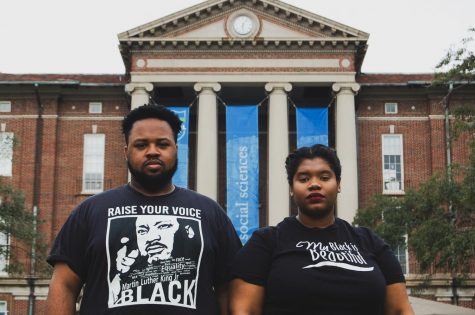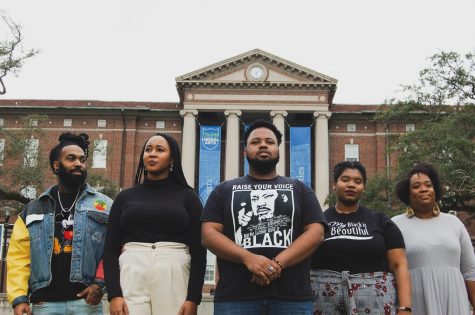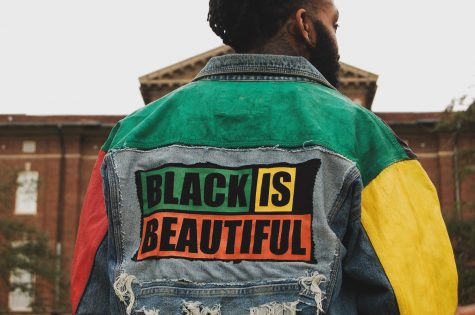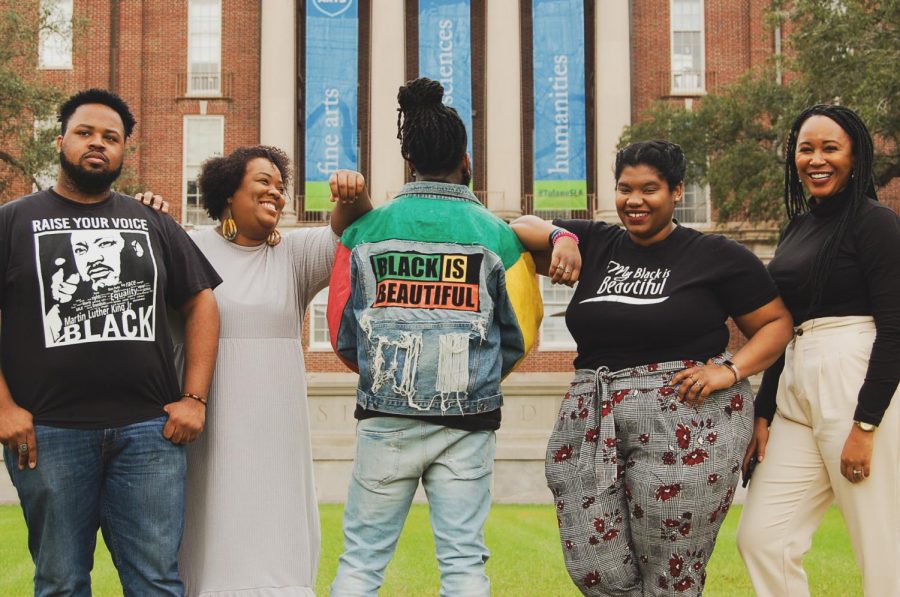‘A more just Tulane’: Black students fight for equity from segregation to present-day
Maggie Pastersz | Associate Photographer
Carl Briggs, Inas Shabazz, Justin Taylor, Maiya Tate, Janelle Williams pose in front of Newcomb Hall.
February 5, 2020
Tulane admitted its first Black students in the fall of 1963. In 2019 Tulane enrolled a record-high 92 Black students. A look back at the history of the Black student experience at Tulane allows for reflection on the progress the institution has made and highlights a need for continued work.
Like most private institutions, especially in the South, Tulane did not admit Black students at the time of desegregation. Paul Tulane wrote in his 1882 letter of donation that the university should be used for “the promotion and encouragement of … education among the white young persons in the city of New Orleans.”
Tulane University was integrated by two Dillard University alumni who wanted to attend graduate school there. #BlackHistoryMonth #DillardHeritageMonth #foreverBLEU
— The Renaissance (@SGA_DU) February 6, 2018
These words that became a part of the Tulane charter played a role in the Tulane Board’s attitudes toward integration. In their book “Tulane: The Emergence of a Modern University,” Clarence Mohr and Joseph Gordon write that “No members of the Board expressed enthusiasm over the prospect of admitting black students, and it seems likely that most who supported the idea did so reluctantly.”
“I know that [integration] was contentious and that the institution fought long and hard to try to avoid [it] for as long as they could until they were absolutely forced to integrate,” Tulane history professor Randy Sparks, who specializes in the Old and New South, said. “So I think it was a difficult task at Tulane as it was at many southern institutions and many private southern institutions.”
This did not stop Tulane from admitting students from other underrepresented backgrounds who weren’t Black, such as women and international exchange students. Keira Williams, a lecturer in the school of history, anthropology, philosophy and politics at Queen’s University Belfast wrote about these practices.
“‘White’ apparently meant ‘not Black’ to Tulane administrators through the first half of the twentieth century,” Williams wrote.

Carl Briggs, Inas Shabazz, Justin Taylor, Maiya Tate, Janelle Williams pose in front of Newcomb Hall.
Although the faculty of Tulane’s graduate school was in favor of amending the admissions policy to allow Black students to attend, the Board of Administrators disagreed.
Aside from personal prejudices that may have contributed, members felt bound by the stipulations of benefactors like Paul Tulane and Josephine Louise Newcomb who both desired that admission be limited to white students.
What ultimately pushed board members to desegregation was the Ford Foundation’s decisions not to include Tulane in its challenge grant program. The Ford Foundation refused to provide Tulane grants unless the university integrated. In 1961, the board enacted its desegregation policy.
In 1963 Tulane admitted its first Black students, Pearlie Elloie and Barbara Guillory Thompson. Elloie was a native New Orlenian, mother and graduate of Dillard University. Thompson was also a graduate of Dillard and had earned her master’s from LSU.
Both women wanted to earn higher degrees closer to home and were willing to challenge Tulane in order to do so. After a long two-year court case, Elloie and Thompson finally gained admission to Tulane to pursue their degrees.
“It was the easiest decision to make,” Elloie said in an interview with Louisiana Weekly. “It was what I needed, and I had the support I needed.”

Carl Briggs, Inas Shabazz, Justin Taylor, Maiya Tate, Janelle Williams pose in front of Newcomb Hall.
Current judge Edwin Lombard created the African American Congress at Tulane — now the Black Student Union — in 1969 to provide Black students with the same community and opportunities that white students had on campus.
“We didn’t have anyone to tell us the best classes to take or which professors to avoid,” Lombard said in a 2013 interview with Tulane magazine. “I started the African American Congress to do what I knew the fraternities and other social organizations around campus were doing for the white students.”
The African American Congress promoted cultural awareness through a variety of programs and events, much like BSU does now. It was also responsible for creating the Black Arts Festival.
Sophomore Claude Hill reflected on this history and what it means to be a Black student at Tulane today.
“Tulane has an extremely racist history, but to think of the work that has been done particularly by Black people to get where we are now is truly inspiring,” Hill said. “Although more change is much needed to create a more equitable education and inclusive space for all, by following in footsteps of the trailblazers before, we can achieve the change that needs to happen.”
On campus today, BSU and other student organizations and student leaders are working to create an equitable Black student experience at Tulane. For example, Students Organizing Against Racism facilitates Tours of Truth aimed at educating the community on the history of racism and hardship that Tulanians and New Orlenians have faced in the past.
“The Tours of Truth was created from the organization SOAR as to really tell the history of Tulane through the buildings and the people that funded them,” Carolyn Barber-Pierre, assistant vice president of student affairs and multicultural affairs, said. “We know that Gibson and Tulane and Hebert were segregationists, some of them confederate supporters, and the Tours of Truth talk about that history that Tulane doesn’t always want to talk about.”
Community Engagement Advocates also help educate students on how to recognize their own privilege and how to navigate and be intentional about their interactions with minorities on campus and in New Orleans.
The CEA program works in partnership with The Carolyn Barber-Pierre Center for Intercultural Life, which has its own student peer mentors who help incoming freshmen navigate a predominantly white institution.
While organizations for Black students and students of color have grown, Sparks argued Tulane needs to enroll more Black students to see meaningful change.
“A lot depends on numbers. There’s only so much you can grow, say, a campus organization if you don’t have more students, there’s only so much that can be accomplished,” Sparks said. “In some ways I think everything hinges on that enrollment ratio, and until those numbers go up I don’t know how much change you’re really going to see.”

Carl Briggs, Inas Shabazz, Justin Taylor, Maiya Tate, Janelle Williams pose in front of Newcomb Hall.
Since the moment Elloie and Thompson set foot on campus, Black students have shaped the history of the Black student experience. Black students and organizers continue to push for representation and change.
Graduate student Abi Mbaye highlighted the work students have done on campus in recent years, including a die-in to bring attention to police brutalities against Black bodies, a call for unity to hold the university accountable for its mistreatment of students of color, providing support and resources to undocumented students and passing an equity fee through the Undergraduate Student Government.
“Generation after generation of student activists have come together to fight for a more just Tulane,” Abi Mbaye said.
Black students may make up a small percentage of Tulanians, but their struggle for recognition and equality has been central in shaping the history of this university.
“I think we’re at a point where we’re acknowledging [Tulane’s racist history] and moving forward,” Barber-Pierre said. “When I got here there were only about three student of color organizations, now we have about twenty.”
Black students have shaped our history, and they will continue to shape our future.























Ann Case • Feb 12, 2020 at 12:32 pm
According to the published Enrollment Statistics for Fall 2019, linked through the Registrar’s website, 92 is the number of responses of first-time, full-time freshmen who self-identified as African American, but there were also 438 first-time, full-time freshmen students who self-identified as “Students of Color”, and another 104 first-time, full-time freshmen who self-identified as “Multi-racial” students. Perhaps these broader, less specific categories are useful for not labeling people, but are not helpful when someone is trying to use the charts for statistical purposes…
Hewittz • Feb 8, 2020 at 9:46 pm
Doesn’t the equity bill have to go through a second time because they changed their legislation to exclude a handful of minority organizations?
Hewittz • Feb 8, 2020 at 9:44 pm
bruh didn’t BSU go on hiatus bc their president was incompetent and unwelcoming lol
Anayansi Konrad • Feb 7, 2020 at 11:15 am
‘Preservation of one’s own culture does not require contempt or disrespect for other
cultures.’–César Chávez
I am grateful I spent a whole Saturday last month with the Anti-Racist Leadership Institute in room B09 Newcomb Hall. My encounter with Raven Ancar and Abi Mbaye during that workshop has been critical in my education in all levels of life ever since. I encourage the TU student population to contact said powerful student leaders: you need to hear what they have to say. Another key component of the work being done to make inclusivity and diversity in TU more than a trendy pr campaign is Ben Brubaker, Program Manager for Academic Student Leadership Development at the Tulane Center for Public Service. Don’t hesitate to call/write him. You will be enlightened. It’s never too late to make a uturn.
Robert Perry • Feb 6, 2020 at 10:20 am
Thank you for this very informative and encouraging article. On another note, I am having problems accessing my Tulane email: [email protected] I still use [email protected]
Thanks